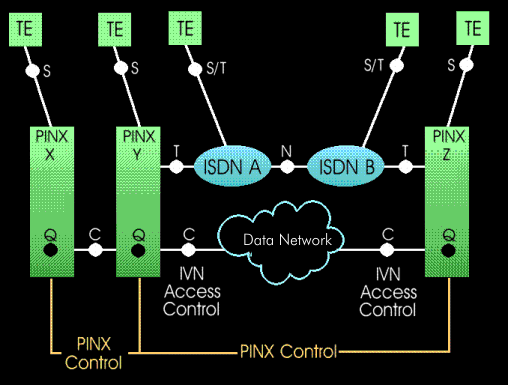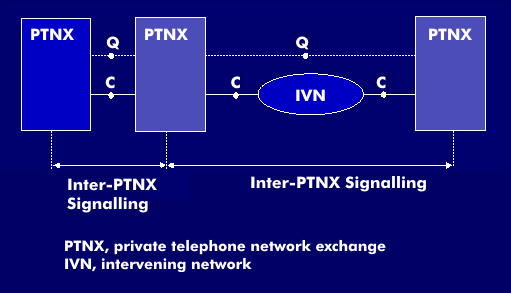Q-interface signalling protocol (QSIG)
Q-Interface Signalling Protocol (QSIG) is an international signaling standard defined by the European Computer Manufacturers Association( ECMA) for logical signaling between two private switching nodes, e.g. PBXs. In addition, QSIG standards derived from Q.931 have been elevated to European and international standards by European Telecommunications Standards Institute( ETSI) and the International Standards Organization( ISO).
The International Standards Organization (ISO) had developed a QSIG standard at the same time as ETSI under the name Private Signalling System 1( PSS1) and publishes its standard, to which ETSI has adapted, under the name ISO-QSIG.
QSIG is intended to enable operators of corporate networks to interconnect different PBX systems to form a heterogeneous network and to use cross- system features such as automatic call forwarding. With the Generic Functions, QSIG-GF, QSIG offers a solid foundation for adding different features to the Basic Call, QSIG-BC, similar to a modular principle. These can be purely QSIG-compliant, QSIG-compliant with manufacturer-specific extensions and also manufacturer-specific.
QSIG as a powerful signaling system
QSIG is a modern, high- performance signaling system for signaling between PINX(Private Integrated Service Digital Network Exchange) facilities, specifically designed to meet the requirements of telecommunications services in a corporate network. QSIG is a vendor-independent standard supported by the world's largest PBX manufacturers. The manufacturers committed to its development in a February 1994 MoU. The signaling system is designed to support all network structures, such as star topology, bus topology, meshed network, or tree topology, as well as any number of node computers.
QSIG is based on the D- channel protocol according to the ITU-T standard of the Q.93x series for Basic Call and the Q.95x series for Supplementary Services. This ensures that QSIG and ISDN are compatible in their features and that ISDN applications or supplementary services of the public ISDN networks can also be used in a private network. In addition to the supplementary services of ISDN, various other supplementary services are specified for QSIG. Among others Name Identification, Call Intrusion, Do Not Disturb, Path Replacement, Operator Services, Mobility Services, Call Completion and some more. In addition, applications developed specifically for ISDN can be run on the QSIG Corporate Network
The architecture of QSIG
The architecture of QSIG is essentially the same as the ISDN architecture, although in addition to the N, T and S reference points, two new reference points are added, the Q point and the C point.
The Q reference point is the logical signaling point between two private branch exchanges, and the C reference point is the reference point for the physical connection.
The QSIG standard specifies a signaling protocol at the Q reference point between two Private Telephone Network Exchanges (PTNX) that can be used primarily on any ordinary channel. The protocol stack of QSIG is identical to the DSS1 protocol, Digital Subscriber System no. 1 (DSS1). Both are based on the OSI reference model, both are identical in the physical layer and the link layer( LAP-D protocol), but differ in the network layer. In QSIG, the Layer 3 protocol consists of three sublayers: the QSIG Basic Call, the QSIG Generic Functional Procedures and the QSIG Procedures for Supplementary Services.


